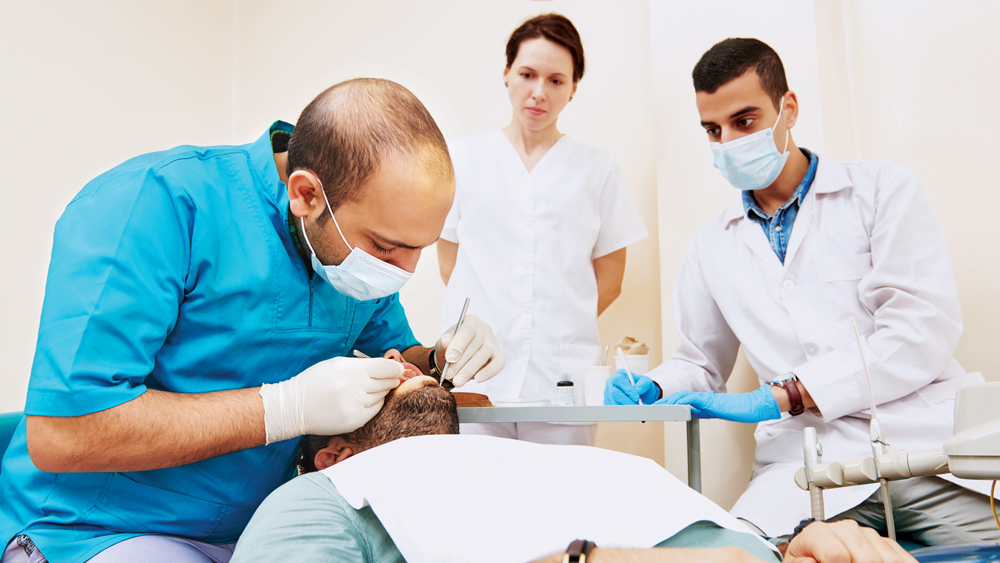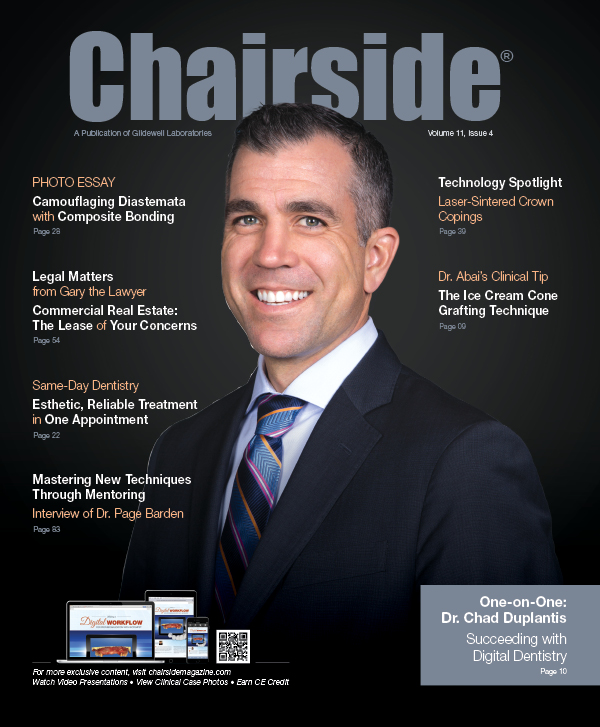Techniques Through Mentoring – An Interview with Page Barden, DDS
Dr. Page Barden is a periodontist who maintains a general dental practice in Cumming, Georgia, and is an American Academy of Facial Esthetics (AAFE) implant faculty member. He earned his dental degree from the University of Detroit Mercy School of Dentistry and a specialty degree in periodontics from Indiana University School of Dentistry. Dr. Barden has taught implant dentistry at both of his dental alma maters and lectured throughout the United States and South America. Here, he discusses the evolution of implant dentistry, why relatively few general practitioners in the U.S. surgically place implants, and the AAFE’s efforts in teaching dental implantology.
CHAIRSIDE® MAGAZINE: Dr. Barden, thanks for being with us. Please tell us about your start in dentistry.
DR. PAGE BARDEN: I completed dental school in 1973 at the University of Detroit. From there, I spent time in the Air Force, and when I came out of the Air Force in 1975, I worked in general practice in Warren, Michigan, a suburb of Detroit. Two years later, I found myself sitting in the graduate periodontics program at Indiana University.
CM: How and when did you get started in implant dentistry?
PB: While at the University of Detroit, I was fortunate enough to have as a classmate Carl Misch. He was voted class president for the three years we were in dental school, and I was the class secretary during that time. When I returned to Michigan to practice periodontics after completing my time at Indiana University, I found that the field of dental implantology was beginning to take off, and eventually I trained to place dental implants. After completing my training, I was asked to come aboard to help teach the other students, and the time there was spent in the laboratory portion of the course. I was practicing in a small town in Michigan, and when I took the course, I felt that it was necessary to take the prosthetic portion as well as the surgical portion so that I would be able to help those dentists who had not been trained in dental implantology with the restorative process.
CM: What was implant dentistry like when you first started?
PB: It was exciting from the standpoint that we were doing things that theretofore had been taboo. We were on the cutting edge of giving patients back the teeth they had lost. We were doing subperiosteals and blade implants at the time, and did not know the pathophysiology of loading these implants. Many worked well, and many patients were very happy. Ramus frames were also being done by some practitioners. The implant companies felt that they should sell to the surgeons, ignoring the fact that implants are restoratively driven.
I recall a lady for whom we placed five implants in the lower arch and the referring dentist built a fixed restoration and a beautiful new upper dental prosthesis. I decided to have fun with her when she returned for a post-op appointment. When she came in, I brought out the office checkbook and wrote out a check in the sum of $20,000. I told her that I would fill in her name if she would let me remove the implants and take away her prosthesis. Before I tell you the answer she gave me, I have to tell you that when I first saw her she was a rather plain-looking lady in her mid-50s who wore no makeup and had little self-respect for her attire. The day of the post-op appointment, she came in nicely dressed and wearing makeup, with her hair coiffed. There had been a total change in her self-esteem. When I asked her to let me take out the implants, her eyes narrowed and she sternly said, “Not on your life.” Implants had changed her life and given back to her the self-esteem she had given up when she had her teeth removed.

CM: How is implant dentistry different today compared to when you first started?
PB: The practice of implant dentistry has progressed phenomenally since I began in 1988. Dental implants are becoming more and more mainstream because patients are requesting not having adjacent teeth reduced for bridge abutments. Those who have suffered without teeth are now able to have the ability to eat, talk and live the life that they had lost. Add to that the ability to reconstruct the restorative portion virtually and, with CAD/CAM procedures, plan the case, build the surgical guide, place the implants and load the case — all in one procedure. On those cases that present with just-right conditions, teeth in a day is a dream come true. Training is becoming better from the beginning to the end.
With the availability of cone-beam computed tomography (CBCT), the predictability of implant dentistry is greatly improved. The downside to CBCT is that it does add significant cost to an implant case, which often prices patients out of implant dentistry. It also has prevented general dentists from learning to place dental implants because they erroneously think that it is needed for every case. CBCT is not needed for the easy dental implant cases, which are those that are in healthy patients, are in areas that have plenty of bone, and are in safe anatomical areas where dentists have properly diagnosed and treatment planned the case. That is where brain-guided surgery comes in, and good training is essential to get started.
CM: Only 10 percent of U.S. dentists surgically place implants today — why do you think that is so?
PB: There are several factors contributing to this. First, dentistry has grown greatly over the past 40 years. Newer materials and procedures have grown exponentially. There is only a limited amount of time in dental school to be able to reach a level of competency to enter general practice, and mastering the basics leaves little room for elective procedures. Upon completion of my dental school, the keynote speaker at graduation reminded each and every one of us who received a license that, although we had completed requisites for licensure, this was but a license to continue learning. Some dentists do not feel that implants fit into their practice. And there are others who think that surgery is out of their reach and they cannot accomplish simple surgical procedures.
Sadly, there are some specialists and implant dentists who think they are the only ones who should be surgically placing implants, and they try to scare the general dentists away. Historically, the dental implant companies have only targeted surgeons as their prospects, though this has changed as these companies focus on the restorative-driven aspects, not just the surgical-driven. Even if the dentist elects to refer to a surgeon to place the implant, the referring dentist is crucial to the treatment plan and should have an initial prosthetic solution worked out so that he or she and the surgeon may work together to benefit the patient. Long gone are the days when the generalist referred a patient to the surgeon for implant placement and accepted what came back.
More and more general dentists are becoming involved with surgically placing dental implants and are very successfully placing as many, if not more, implants as the specialists. Every dentist has the ability to learn how to place dental implants. It gives them the ability to offer more and better treatment services to all of their patients.
CM: Should dentists start with brain-guided or computer-guided implant surgery?
PB: I am honored to be a member of the outstanding and dedicated implant training faculty for the AAFE. In the AAFE Level 1 implant training course, the first thing we teach is brain-guided surgery, which simply means general dentists are taught how to properly diagnose and treatment plan a Level 1 implant case with standard diagnostics that they have in their offices. These cases are in healthy patients, have plenty of bone width and height, and are in safe anatomical areas such as lower first molars. These single-unit cases are the most common cases, making up the bulk of implant dentistry in general dentists’ offices. This is why every general dentist needs to learn how to surgically place dental implants — just for these cases. Imagine how many patients you can help right now in your office.
Brain-guided and computer-guided implants are complementary and not exclusive at all. In terms of sequence, dentists need to be trained in brain-guided surgery first so they know how to diagnose, treatment plan, and place an implant with their minds and their hands before they can learn to work with a CBCT. This may come as a surprise, but computers can be wrong! Maybe not “wrong,” but they are only as good as the information put into them and the dentist who is using the computer-guided surgery. Dentists need to know brain-guided surgery first so they can successfully integrate a CBCT later on in their practices if they choose to do more difficult cases.
The AAFE’s goal is for every general dentist to get started with these easy implant cases and then build on their training and success to incorporate higher levels of implant dentistry should they choose to do so.

CM: Do you enjoy teaching general dentists as they get started with implant dentistry?
PB: Yes. Large group settings, like the interactions at schools, are fine when a required course for graduation is given. However, when working with a small group with a maximum of five people, as we do in the AAFE implant training courses, the opportunity for greater interaction and, subsequently, deeper learning is achieved. I remember placing my first implant on a patient I had brought for the procedure. We had gone through the academic portion and the laboratory portion, and next was the real thing. Dr. Wayne Jarvis, an oral surgeon out of New York, was my mentor, and was sitting on the opposite side of the chair. In no time, the dental implant was in, and the exhilaration I felt was incredible. Now, after many years, it is gratifying to see the same fire lit in the AAFE general dentists who are being trained to surgically place dental implants for the first time.
CM: Dr. Barden, thank you so much for your time. Any final comments?
PB: I will just end with this question, which the AAFE faculty discussed as it was planning the AAFE Dental Implant Now Course: Why is it that, around the world, nearly 90 percent of general dentists surgically place implants with brain-guided surgery, but in North America it is only around 10 percent? Are U.S. general dentists more poorly trained than dentists around the world? Of course not.
The AAFE also realizes the financial challenges of getting started with dental implants, so they are now offering a no-money-down option for everything a dentist needs to get started, including education, equipment and implants, so dentists can pay as they produce with dental implants. Every general dentist has the skills and can learn how to surgically place AAFE brain-guided Level 1 dental implant cases right now — and they should do so immediately. This will increase access to care in the U.S., provide better treatment outcomes, and dramatically raise the level of implant dentistry for patients and dentistry as a whole. I would tell every general dentist to get trained today!
Learn More
For more information about the American Academy of Facial Esthetics, visit facialesthetics.org, email info@facialesthetics.org or call 800-952-0521.



